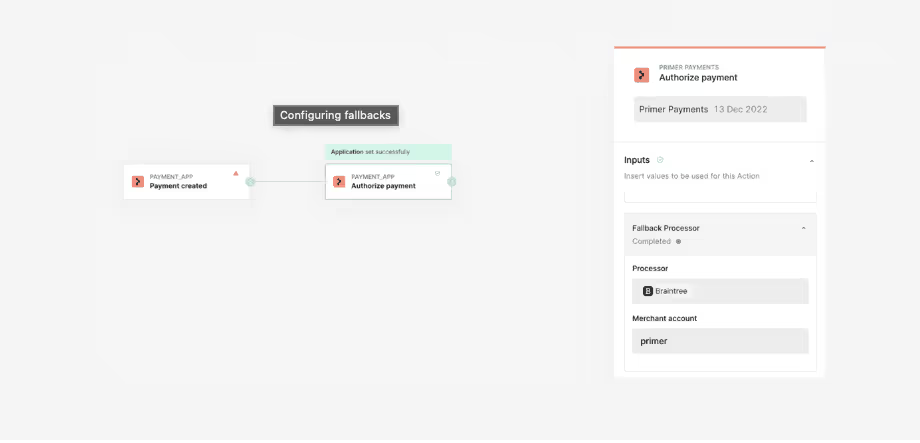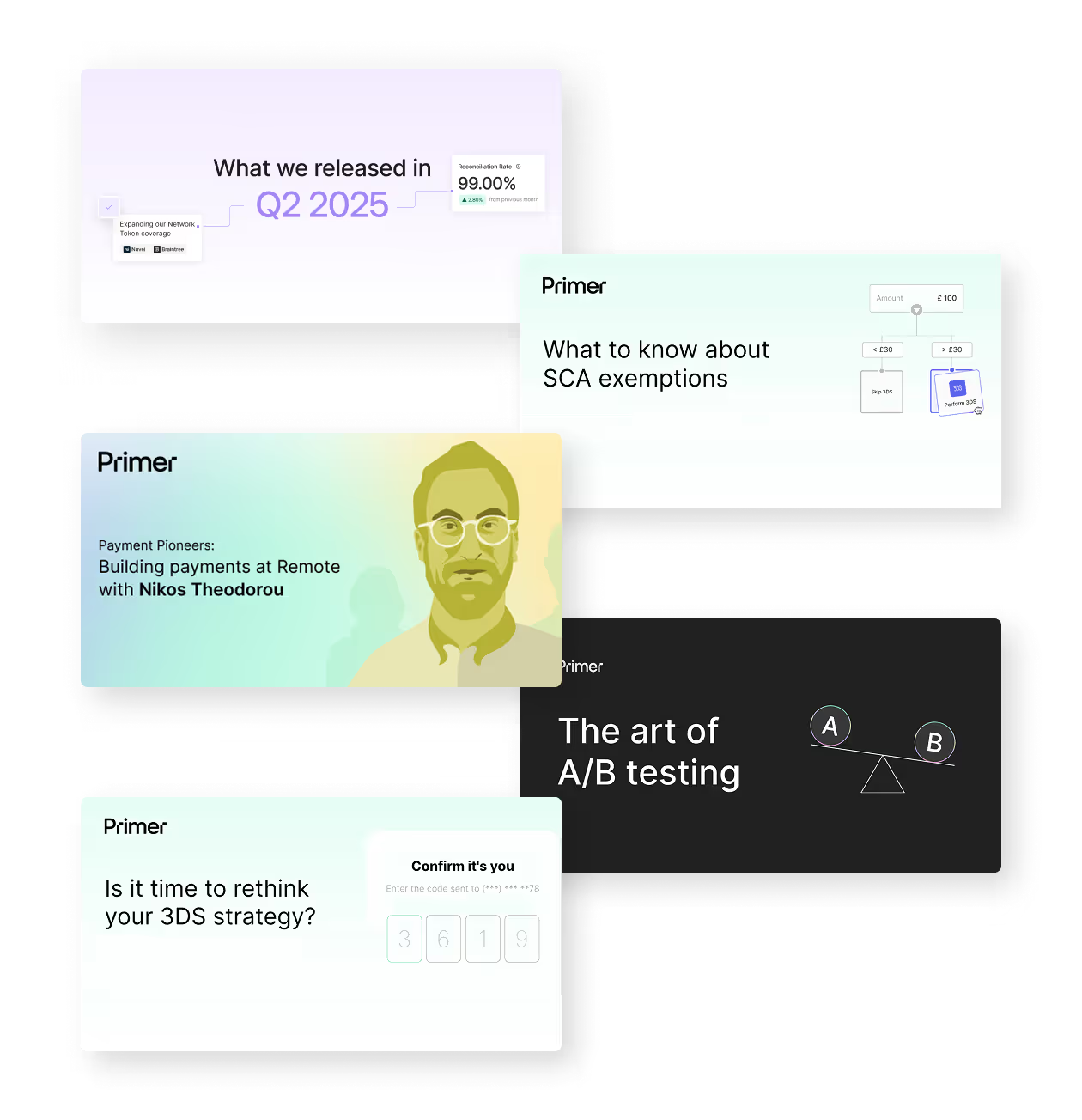Need help finding the right payment processor for your business?
You might be facing issues such as hidden fees that eat into your profits, unreliable performance that hampers your revenue and frustrates your customers, or processor limitations that slow down your international expansion.
To help you find the right payment processors for your needs, we’ll give an overview of five of the top global payment processors.
We’ll also introduce you to a solution that makes adding new processors as fast and straightforward: Primer.
Working with multiple processors doesn't have to be complicated. With Primer, you only need to integrate once to access the most popular processors globally—all through a single API. Book a call with our experts to find out how we can help.
Three questions to ask before choosing a payment processor
A payment processor is the backbone of any payment system, handling the secure movement of funds between the customer’s bank and the merchant’s account. Whether it’s card transactions or Alternative Payment Methods (APMs), processors manage critical tasks like authorizing payments, routing transaction data, and settling funds, ensuring a smooth and reliable payment experience for both parties.
The key differences between processors include:
- Reliability and performance
- Coverage
- Pricing
- Support
- Additional tooling
- Supported payment methods
To help you find the right processors for your business, here are three key questions to consider:
1. Does the processor offer the coverage you need?
Your processor should have coverage in the regions where you currently operate—but don’t forget to plan for the future.
As a global business, it can be challenging to optimize payments when only using a global processor.
For example, Stripe is well-regarded for its strong integrations across Europe. However, if you plan to expand into Southeast Asia, you may need to consider a processor like Airwallex. This processor specializes in supporting local payment methods and networks in that region to maximize payment success rates.
2.Can your processor offer the payment methods your customers want?
In certain regions, compatibility with local payment methods can be a dealbreaker.
Let's say you're planning to scale in China—you'll need a processor that supports Alipay and WeChat Pay as payment methods. These two payment options dominate China's mobile payment landscape, with Alipay holding approximately 54% of the market and WeChat Pay capturing around 40%. You'll be at a competitive disadvantage if you only offer card payments.
Other important alternative payment methods to look out for include:
- Digital wallets, such as Apple Pay and Google Pay
- Buy Now, Pay Later (BNPL) options like Klarna or AfterPay
- Relevant regional payment methods, such as iDeal in the Netherlands or Giropay in Germany
Incorporating regional payment methods can make or break your payment strategy. To find out more, check out our guides to alternative payment methods in specific regions:
3.What is the fee structure?
Many payment processing companies offer a blended pricing model. This model combines interchange costs, assessment fees, and processor markup into a single, flat transaction fee. This 'fixed fee' model offers simplicity in managing costs.
However, some businesses prefer interchange plus plus (IC++) pricing. IC++ gives merchants more granularity over fees, allowing them to see how much they pay for each service used when processing a payment. IC++ isn’t just more transparent; it also allows businesses to identify opportunities for cost optimization.
Regardless of the pricing model you prefer, it's worth keeping an eye out for any additional fees, including:
- Setup fees: One-time charges for initiating your account or integration.
- Chargeback fees: Costs incurred for disputed card transactions can quickly increase in high-risk industries.
- Hidden fees: Unexpected charges, like monthly fees for account maintenance, early termination penalties, or additional transaction processing fees for specific payment methods.
An overview of five top payment processors
Here's an overview of five reliable global payment processors to help you visualize their differences:
What if you could easily access all five processors and switch between them, choosing the one best suited for each scenario—all with just a click? With Primer, this becomes a reality. Discover how we make it happen.
Is there a ‘best’ payment processor for you?
If you’re an ambitious business looking to scale, no single payment processor can meet your every business need.
The most effective strategy is to use multiple processors, leveraging each one’s strengths.
For example, a global processor might offer better reliability and lower fees across Europe, while another may provide comparable reliability at a more affordable rate in Latin America. By using both, you can enhance coverage and build a resilient, cost-effective payment setup that supports your business as it grows globally.
Even if you’re not operating globally, relying on just one processor leaves you vulnerable. If they experience downtime, your payments—and revenue—could come to a halt without a backup processor to step in and retry the payment.
How to integrate with multiple payment processors (through one API)
Thankfully, there’s a way to connect to multiple payment processors without expending engineering resources to integrate and maintain the connections.
Introducing Primer, a unified payments infrastructure that helps businesses accept, optimize, and manage online payments across multiple services—all through a single API integration. By removing technical complexities, Primer empowers you to scale faster and unlock growth opportunities without being limited by traditional payment technology constraints.
Adding new payment processors using Primer’s payment orchestration capabilities takes just a few steps:
1. Select the processor in the Primer Dashboard
2. Give Primer access to your processor account
3. Enable alternative payment methods (non-card) for the processor
4. Configure when and where these payment methods appear for your customers in our Universal Checkout—no coding required.

How Primer can help you accept, optimize, and manage your payments
You’ve already seen how easy it is to add some of the best payment processors to your account. This is just one of the many tools we offer.
With Primer, you can also:
Recover up to 20% of lost revenue with Primer Fallbacks
We’ve mentioned the importance of a backup processor. If your primary processor goes down or declines a transaction, that revenue is gone without a backup processor. However, integrating and maintaining this routing can be complex and resource-intensive.
Primer’s Fallbacks feature solves this problem. When a payment fails and is recoverable, Primer automatically reroutes the transaction to your chosen backup processor, increasing the chances of success.
Best of all, this is done through Primer’s no-code workflow builder, meaning you can set it up with just one click.

The results speak for themselves: Primer customer Banxa, a leading crypto payments platform, achieved a 17% recovery rate using this feature, boosting revenue with little effort.
With Primer, you can easily build a resilient payment system that can handle processor downtime without impacting your bottom line and reputation.
Fallbacks are just one way to use intelligent payment routing to optimize your payment strategy. Read more: A guide to payment routing: Everything you need to know.
Understand the performance of your payment processors with Observability
Managing data across multiple payment processors can feel like untangling a web. Each processor uses its own data structure and reporting system, making it hard to consolidate information and get a clear overview of your payment performance.
Primer’s Observability Dashboard removes this complexity by centralizing and standardizing your payment processor data. With over 100 visualizations and 30+ filters, you can easily analyze metrics by:
- Processor
- Region
- Payment method
- Decline reason
- And more

Another feature you can use is Monitors. This provide real-time alerts whenever performance issues arise, helping you identify and resolve problems before they impact your customers or revenue.

Here’s how Monitors work:
- Static monitors: Set fixed thresholds for key metrics like authorization rates. For example, get an alert if rates drop below 85%.
- Dynamic monitors: Use historical data to predict acceptable performance ranges. Alerts are triggered when metrics like transaction volumes or decline rates fall outside these ranges.
Imagine adding a new processor and noticing its authorization rates suddenly drop. Monitors will flag the issue immediately—through email, webhooks, or even Slack— allowing you to act quickly and investigate the problem.
Optimize your payment strategy with Primer
These are just a few ways Primer can help transform your payments. You can also:
- Increase authorization rates by up to 4% and reduce fraud by up to 30% with network tokenization.
- Streamline payment method management with Universal Checkout.
- Reduce 3DS friction and improve success rates with Primer 3DS.
- Optimize costs and success rates with smart payment routing.
- We're PCI DSS compliant, so your sensitive payment data is protected by industry-standard security measures.
- Compatible with fraud protection tools to help detect and prevent high-risk transactions in real-time.
- Develop and refine your payment strategy with customer support from our expert team.
Ready to take your payment strategy to the next level? Book a call with our payment experts today.
How Primer helped Maisons Du Monde integrate multiple payment processors in days rather than months

Maisons du Monde, a renowned European home decor brand operating in 11 countries, faced mounting challenges in managing its growing payment stack.
As an ecommerce platform, expanding its payment processor network was crucial to meeting customer needs across diverse markets and growing its online sales volume. However, each integration was time-consuming and added operational complexity.
“However, integrating just one payment method takes us a few months, meaning we can’t scale anywhere near as fast as we want. That’s not to mention the challenges we have with operational tasks like reconciliation now that we’re accepting multiple payment methods and using multiple payment processors.” — Jérémy Lechardeur, CTO Direct to Consumer at Maison du Monde.
To overcome these hurdles, Maisons du Monde partnered with Primer. Thanks to Primer’s unified payment infrastructure, they could effortlessly integrate multiple payment processors while reducing the technical burden on their team.
This is critical because we can see that customers abandon their carts in specific markets if they don’t see their preferred payment method.
The team gained deeper insights into processor performance using Primer's Observability Dashboard. This empowered them to make data-driven adjustments and unlock new growth opportunities. With Primer, payments went from a burden to a strategic advantage.
Read the full case study: Maisons du Monde redesigns its payments with Primer.
Work with multiple payment processors with Primer
Finding the right payment processors is just the start. The real challenge lies in managing them efficiently, scaling globally, and staying ahead of evolving customer expectations. Primer simplifies this process, allowing you to integrate with over 40 payment processors, optimize transactions with intelligent routing, and protect your business with advanced fraud detection tools.
Ready to transform your payment strategy and unlock new growth opportunities? Book a call with our experts today.
Sources:
- https://www.paypal.com/us/webapps/mpp/merchant-fees
- https://stripe.com/pricing
- https://www.worldpay.com/global/pricing
- https://www.braintreepayments.com/braintree-pricing
- https://www.adyen.com/pricing
- https://www.paypal.com/us/webapps/mpp/country-worldwide
- https://stripe.com/global
- https://www.worldpay.com/global
- https://www.braintreepayments.com/global
- https://www.adyen.com/global
- https://www.paypal.com/us/webapps/mpp/credit-card
- https://stripe.com/payments/payment-methods
- https://www.worldpay.com/global/payment-methods
- https://www.braintreepayments.com/features/payment-methods
- https://www.adyen.com/payment-methods




(1).png)
.png)